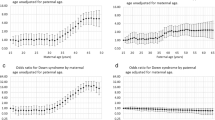Summary
In 35,680 fetuses of women who had prenatal cytogenetic diagnosis done upon amniotic fluid specimens obtained during 2nd trimester amniocentesis and in whom there was no increased cytogenetic risk except for age, there was no statistically significant evidence for an increase of 47,+21 at any paternal age after adjustment for maternal age. The ratio of observed-to-expected numbers in fathers less than 30 years old was 1.0 and in fathers 40 years or older was 0.9 when compared with numbers derived from maternal-age-specific rates in men 30–39 years old. The ratio was 1.1 for those younger than 34 years when compared with rates in fathers aged 34–39 years old. Only for men 55 years or older was there any, even suggestive, increase. The ratio was roughly 1.5 (9 observed to about 6 expected). This was not statistically significant, and moreover, the increase such as it was, was in men married to women 37–42 years old. Regression analyses using several additive parental age models introducing a parabolic function for paternal age, failed to reveal any paternal age contribution.
Similar content being viewed by others
References
Ferguson-Smith MA, Yates JRW (1984) Maternal age specific rates for chromosome aberrations and factors influencing them: report of a collaborative European study on 52,965 amniocenteses. Prenat Diagn 4:5–44
Hook EB (1978) Differences between rates of trisomy 21 (Down's syndrome) and other chromosomal abnormalities diagnosed in livebirth and in cells cultured after 2nd trimester amniocentesis —suggested explanations and implications for genetic counseling and program planning. In: Summitt RL, Bergsma D (eds) Sex differentiation and chromosomal abnormalities. Liss, New York, pp 249–267
Hook EB (1981) Interchange trisomic Down's syndrome and Patau's syndrome: general approaches to estimating mutation rates and epidemiological advantages for monitoring. In: Hook EB, Porter IH (eds) Population and biological aspects of human mutation. Academic Press, New York London, pp 167–190
Hook EB (1982) The epidemiology of Down syndrome. In: Pueschel SM (ed) Down syndrome: advances in biomedicine and the behavioral sciences. Ware Press, Cambridge, Mass, pp 11–88
Hook EB (1983) Chromosome abnormalities and spontaneous fetal deaths following amniocentesis: further data and associations with maternal age. Am J Hum Genet 35:110–116
Hook EB (1984) Parental age and unbalanced Robertsonian translocations associated with Down syndrome and Patau syndrome: comparison with maternal and paternal age effects for 47,+21 and 47,+13. Ann Hum Genet 48:313–325 (see also Corrigendum 49:163, 1985)
Hook EB (1985) Maternal age, paternal age, and human aneuploidy: nature, magnitude, etiology and mechanisms of effects. In: Dellarco VL, Voytek PE, Hollaender A (eds) Aneuploidy: etiology and mechanisms. Plenum Press, New York, pp 117–132
Hook EB (1987a) Issues in analysis of data on paternal age and 47,+21: implications for genetic counseling for Down syndrome. Hum Genet 77:303–306
Hook EB (1987b) Appendix: A general regression model for analysis of independent maternal and paternal age effects for 47,+21 and other disorders that may arise from mutant gametes from either parent. Hum Genet (1987) 77:314–316
Hook EB, Chambers GM (1977) Estimated rates of Down's syndrome in livebirths by one year maternal age intervals for mothers aged 20 to 49 in a New York State study — implications of the “risk” figures for genetic counseling and cost benefit analysis of prenatal diagnosis programs. In: Bergsma D, Lowry RB, Trimble BK, Feingold M (eds) Numerical taxonomy of birth defects and polygenic disorders. Liss, New York, pp 123–141
Hook EB, Cross PK (1982) Paternal age and Down syndrome genotypes diagnosed prenatally: no association in New York data. Hum Genet 62:167–174
Hook EB, Lindsjo A (1978) Down's syndrome in livebirths by single year maternal age interval in a Swedish study: comparison with results from a New York State study. Am J Hum Genet 30:19–27
Hook EB, Cross PK, Schreinemachers D (1981) The evolution of the New York State Chromosome Registry. In: Hook EB, Porter IH (eds) Population and biological aspects of human mutation. Academic Press, New York London, pp 167–190
Hook EB, Cross PK, Regal RR (1984) The frequency of 47,+21, 47,+18, and 47,+13 at the uppermost extremes of maternal ages: results on 56,094 fetuses studied prenatally and comparisons with data on livebirths. Hum Genet 68:211–220
Jenkins RL (1933) Etlology of mongolism. Am J Dis Child 45:506–519
Lamson SH, Hock EB (1980) A simple function for maternal age specific rates of Down's syndrome in the 20–49 age interval and its' biological implications. Am J Hum Genet 32:743–753
Lamson SH, Hock EB (1981) Comparison of mathematical models for the maternal age dependence of Down's syndrome rates. Hum Genet 59:232–234
Mantel N, Stark ER (1966) Paternal age in Down syndrome. Am J Ment Defic 71:1025
Penrose LS (1933) The relative effects of paternal and maternal age in mongolism. J Genet 27:218–224
Stene J, Stene E (1978) On data and methods in investigations in parental age effects. Ann Hum Genet 41:465–468
Stene J, Stene E, Stengel-Rutkowski S, Murken J-D (1981) Paternal age and Down's syndrome. Data from prenatal diagnoses (DFG). Hum Genet 59:119–124
Stene E, Stene J, Stengel-Rutkowski S (1987) A reanalysis of the New York State prenatal diagnosis data on Down's syndrome and paternal age effects. Hum Genet 77:299–302
Author information
Authors and Affiliations
Rights and permissions
About this article
Cite this article
Cross, P.K., Hook, E.B. An analysis of paternal age and 47,+21 in 35,000 new prenatal cytogenetic diagnosis data from the New York State Chromosome Registry: no significant effect. Hum Genet 77, 307–313 (1987). https://doi.org/10.1007/BF00291415
Received:
Revised:
Issue Date:
DOI: https://doi.org/10.1007/BF00291415




